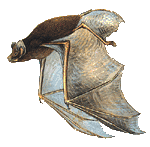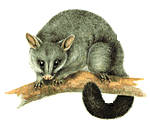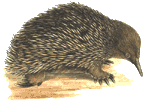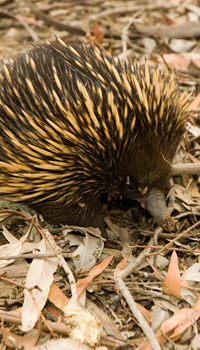Mammals in the Gardens
The most common mammals in the Australian National Botanic Gardens are the several
species of small insectivorous tree-dwelling bats which may be seen flying at
dusk. The smallest of these, the Little Brown Bat, weighs only 3-4 grams and
is smaller than some insects; it is, in fact, one of the tiniest bats in the
world. By comparison, the Grey-headed Flying-fox is a veritable giant, having
a wingspan exceeding a metre and body weight of nearly a kilogram. It occasionally
visits the Gardens in summer, in search of the flowers and fruit upon which
it feeds.
Claw marks on some of the smooth-barked trees usually indicate the presence
of one of the possums, which sleep by day in tree hollows. The Brush-tailed
Possum and the Sugar Glider are fairly common. Sugar Gliders feed extensively
on insects and the flowers of trees and shrubs, whereas Brush-tails, and the
less common Ring-tailed Possums, tend to rely more on leaves for food.
Two macropods can occasionally be seen in the Gardens, although they are not
encouraged, coming in through a gate or fence break from the surrounding reserve.
The Eastern Grey Kangaroo is easy to see during a walk on the surrounding Black
Mountain Reserve at dusk, while the Swamp Wallaby is much shyer, inhabiting
the denser vegetation of the gullies.
Two native ground-dwelling mammals occur in the Gardens: the Yellow-footed Marsupial
Mouse and the egg-laying Echidna occasionally wander in from adjacent woodland
on Black Mountain. Both species are insectivorous
Feral cats and European rabbits and hares are unfortunately fairly common in
the Gardens, and black rats and house mice are also present, but not in large
numbers. Foxes are also seen occasionally.
Mammals commonly seen in the Gardens
| Bats |  |
||
| Grey-headed Flying-fox | Pteropus poliocephalus | Illustration | |
| White-striped Freetail-bat | Nyctinomus australis | ||
| Lesser Long-eared Bat | Nyctophilus geoffroyi | Photo | |
| Gould's Long-eared Bat | Nyctophilus gouldii | Illustration | |
| Gould's Wattled Bat | Chalinolobus gouldii | ||
| Chocolate Wattled Bat | Chalinolobus morio | Illustration, photo, story | |
| Little Forest Bat | Vespadelus vulturnus | ||
| Southern Forest Bat | Vespadelus regulus | ||
| Marsupials |  |
||
| Sugar Glider | Petaurus breviceps | Illustration | |
| Common Brushtail Possum | Trichosurus vulpecula | Illustration | |
| Common Ringtail Possum | Pseudocheirus peregrlnus | Illustration | |
| Yellow-footed Marsupial Mouse | Antechinus flavipes | ||
| Eastern Grey Kangaroo | Macropus giganteus | Illustration | |
| Swamp Wallaby | Wallabia bicolor | Illustration | |
| Monotreme |  |
||
| Echidna | Tachyglossus aculeatus | Illustration, Photo | |
| Introduced mammals | |||
| Cat | Felis catus | ||
| Rabbit | Oryctolagus cuniculus | ||
| Brown Hare | Lepus capensis | ||
| Black Rat | Rattus rattus | ||
| House Mouse | Mus musculus | ||
| European Red Fox | Vulpes vulpes |
Names updated according to 'The Mammals of Australia', 1995, by R Strahan.
![Director of National Parks [logo]](../../../../../images/dnp_90px.gif)






